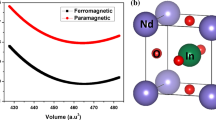Abstract
A vibronic charge-transfer exciton, which is a pair of Jahn-Teller electron and hole polarons, is considered as a possible cause of the appearance of the Müller phase in the virtual ferroelectric SrTiO3 and the “green” luminescence in the virtual ferroelectric KTaO3. The two “green” luminescence bands can be associated with emission from two states of a typical intrinsic defect, viz., a vibronic charge-transfer exciton trapped by an oxygen vacancy and an isolated vibronic charge-transfer exciton. In both cases the “green” luminescence corresponds to the recombination of the electron and the hole in the vibronic charge-transfer exciton, which is accompanied by the emission of light. The properties of the Müller phase can be attributed to mixing of the normal state and states of the vibronic charge-transfer exciton phase when they interact with polarization in the soft SrTiO3 matrix under the conditions of a pseudo-Jahn-Teller (pseudo-JT) effect on a soft TO mode of the displacement type. In this case the vibronic charge-transfer exciton phase forming the low-lying excited states has “order-disorder” degrees of freedom and exists at temperatures significantly below the point of the order-disorder ferroelectric transition in SrTiO3 at T=T Q≈37 K. The corresponding lowering of the symmetry of the vibronic charge-transfer exciton phase to polar symmetry leads to the possibility of a long-period incommensurate phase in such excited states, which arises as a result of the appearance of a Lifshitz invariant. The valence-band state making the largest contribution of the pseudo-JT effect corresponds to a wave vector equal to the critical wave vector of the incommensurate vibronic charge-transfer exciton phase. When the temperature is lowered, the pseudo-JT distortion increases down to ∼T Q and subsequently saturates in accordance with the saturation of the dielectric constant. The basic assumption in the model is that the temperature T=T Q corresponds to the narrow temperature range for the transition from an intermediate to a strong pseudo-JT effect under the conditions for the realization of polarization tunneling states. The appearance of a significant admixture of states of the modulated ferroelectric vibronic charge-transfer exciton phase to the ground state under the conditions for the realization of polarization tunneling states at low temperatures provides an explanation for the principal properties of the Müller phase.
Similar content being viewed by others
References
W. A. Harrison, Electronic Structure and the Properties of Solids: The Physics of the Chemical Bond, W. H. Freeman, San Francisco (1979); Mir, Moscow (1983).
V. S. Vikhnin, Proc. Est. Acad. Sci., Phys. Math. 44(2/3), 164 (1995).
V. S. Vikhnin, Z. Phys. Chem. (Munich) 201, 201 (1997).
V. S. Vikhnin, Ferroelectrics (1997) (in press).
E. Yamaichi, K. Watanabe, K. Imamiya, and K. Ohi, J. Phys. Soc. Jpn. 56(5), 1890 (1987).
E. Yamaichi, K. Watanabe, and K. Ohi, J. Phys. Soc. Jpn. 57, 2201 (1987).
S. Kapphan and S. Magnien, in Proceedings of the DFG-Meeting, Münster, Germany (March 1997).
K.-A. Müller, W. Berlinger, and E. Tosatti, Z. Phys. B: Condens. Matter 84, 277 (1991).
E. Courtens, G. Coddens, B. Hennion, B. Hehlen, J. Pelous, and R. Vacher, Phys. Scr. T 49, 430 (1993).
H. Haken, Z. Phys. 146, 527 (1956); Nuovo Cimento 3, 1230 (1956).
V. S. Vikhnin, S. Kapphan, and J. Seglins, in The 9th International Meeting on Ferroelectricity, Seoul, Korea (August, 24–29, 1997), Abstr. p. 257. Rep. P-08-TH-287.
S. Magnien, C. auf der Horst, and S. Kapphan, ibid., Abstr. p. 166. Rep. O-07-TU-A10.
E. I. Golovenchits, V. A. Sanina, and A. V. Babinskii, JETP Lett. 63, 674 (1996).
Author information
Authors and Affiliations
Additional information
Fiz. Tverd. Tela (St. Petersburg) 40, 907–909 (May 1998)
Rights and permissions
About this article
Cite this article
Vikhnin, V.S., Kapphan, S. Vibronic charge-transfer excitons: Possible nature of the unusual properties of virtual perovskitelike ferroelectrics. Phys. Solid State 40, 834–836 (1998). https://doi.org/10.1134/1.1130415
Issue Date:
DOI: https://doi.org/10.1134/1.1130415




